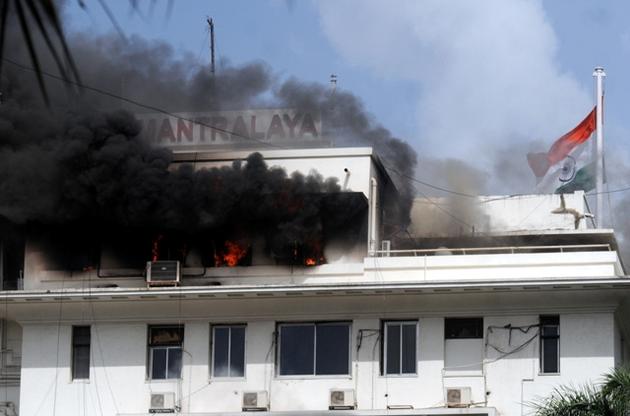
Mumbai, June 21: A devastating fire in the Maharashtra government secretariat, including offices of the Chief Minister and the Deputy Chief Minister, today left three persons dead and 16 injured and destroyed large number of files, raising questions on whether any sabotage was the cause.
Fire brigade officials said two bodies were recovered from the sixth floor of the seven-storey 'Mantralaya'. While one body was found in the committee room of the Deputy CM Ajit Pawar's office, another was found in the nearby waiting hall.
The fire, which erupted at around 2.45 pm and was still raging late tonight, is believed to have resulted in the destruction of files in several departments including that of Urban Development which is in the eye of the Adarsh housing scam involving several top politicians, bureaucrats and ex-army officials.
While announcing an inquiry by the Crime Branch into the fire, Chief Minister Prithviraj Chavan said there were backup files on being asked whether important documents had been lost in the fire. He said that 3.18 crore pages from 2.27 lakh files were scanned and thus safe.
CBI also sought to allay apprehensions about files on Adarsh scam being destroyed, saying they have copies of all the relevant documents.
"We had taken all documents required as part of investigations from the state government last year itself soon after registration of the FIR. Even hard drives from the computers in various departments like the Urban Development department were seized by us last year," a senior CBI officer said. Asked by reporters whether it could be an act of sabotage, the Chief Minister said, "We don't want to jump to any conclusion. The Crime Branch will probe the incident."
The BJP wanted the sabotage angle to be probed. "We need the truth to come out and justice to be delivered to those widows of Kargil, for whom that land was allotted," BJP spokesperson Nirmala Sitharaman said.
The fire was first noticed on the fourth floor near the office of Tribal Welfare Minister Babanrao Pachpute, soon spreading over to the upper floors, aided by the sea breeze. The fourth floor also houses the urban development department.
The fire spread to the fifth and sixth floors in the seven-storeyed 'Mantralaya'. Extensive damage was also caused to the offices of CM and his deuputy on the sixth floor.
According to Relief and Rehabilitation Secretary Pravin Pardeshi, 65 people trapped on the fifth and sixth floor were evacuated by the fire-fighters.
Two helicopters of the Indian Navy were pressed into service to evacuate those trapped inside the building but returned without any success as nobody could be found on the terrace of the building in south Mumbai.
Contingents of the anti-terror force--Force One and Quick Response Teams of Mumbai police assisted the fire brigade in trying to bring the blaze under control.
Pardeshi said nearly 3000 government employees and as many visitors were removed safely after the blaze started.
Relief and rehabilitation Minister Patangrao Kadam admitted that the government had never anticipated such a major fire at the seat of Maharashtra administration and added that the damage caused to the building would be assessed soon.
Chavan, Pawar and Home Minister R R Patil supervised the rescue efforts.
Pardeshi said the fire was first noticed in an electrical fuse and soon a general alarm was sounded across Mantralaya asking people to rush out.
By 3 pm everybody, barring the 65 trapped due to "ballooning" of the smoke, had been evacuated, he said.
Those hospitalised included Chief Minister's Public Relations Officer Satish Lalit, PROs in Deputy CM's office Vishal Dhage and Sanjay Deshmukh and state Home Minister's PRO Kishore Gangurde. All of them had inhaled the smoke, he said.
Electric supply to the building was stopped.
"Video recording of the entire buildings will take place. Senior officials, including secretaries, will inspect the damage," the chief minister said.
No official work will be carried out in Mantralaya tomorrow, and all meetings scheduled have been cancelled, he said.
Meanwhile, a Brihanmumbai Municipal Corporation (BMC) official said that fire brigade received the first call informing about the blaze at 2:46 PM, following which 3 fire engines, 2 water tankers, and an ambulance were rushed to the spot.
The injured persons have been admitted to various hospitals, including 11 at JJ and St George, 3 at G T and 2 at Nair hospital.
Some of them have suffered suffocation, while others have sustained minor injuries to hands and legs, J J Hospital dean Dr T P Lahane said.
There were around 2,500 Mantralaya staffers in the building, apart from around 2,000 visitors when the fire broke out, a Mantralaya official said.
The Mantralaya building typically houses around 8,000 employees on a normal working day.






Comments
Add new comment